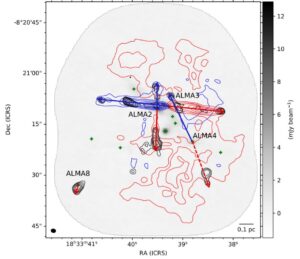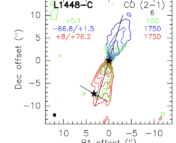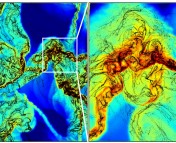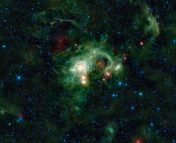Authors: Kaho Morii, Patricio Sanhueza, Fumitaka Nakamura, James M. Jackson, Shanghuo Li, Henrik Beuther, Qizhou Zhang, Siyi Feng, Daniel Tafoya, Andrés E. Guzmán, Natsuko Izumi, Takeshi Sakai, Xing Lu, Ken’ichi Tatematsu, Satoshi Ohashi, Andrea Silva, Fernando A. Olguin, Yanett Contreras
First Author’s Institution: The University of Tokyo
Status: Accepted to The Astrophysical Journal [closed access]
Despite attempts to probe the early stages of massive star formation, those critical phases are still shrouded in mystery. Massive stars (greater than 8 solar masses) enrich the interstellar medium with heavy elements expelled through stellar winds and eventually collapse and release even more material through supernovae. That’s why understanding their formation is essential for understanding the entire feedback cycle within the Universe.
Massive stars form out of dense “clumps” of material. One promising area for hosting such clumps is the infrared dark cloud IRDC 18310-4. In today’s paper, the authors use the ALMA Survey of 70 µm Dark High-mass Clumps in Early Stages (ASHES) to look at the cloud and what may be hidden within.
Getting to the Core(s) of the Problem
The authors begin by examining an ALMA image of the cloud (see Figure 1), which shows the continuum dust emission at 1.3 mm. The main cloud is in the center, brightest part of the image, running from north-east to south-west. The contours in white trace the emission and are concentrated in the areas where it is highest.
Using this image and specific requirements for brightness and spatial separation, the authors determine that there are 11 cores within the cloud, which are marked in Figure 1 by the cyan ellipses. They label the brightest cores ALMA1-8 and the other cores sub1-3. These cores are important because they’re the most likely sites for future (or maybe even current!) massive star formation.

Figure 1. The ALMA dust continuum emission at 1.3 mm. Contours show the increasing flux in the cloud, which runs diagonally from the upper left to lower right. Cyan ellipses mark the 11 clumps (labeled ALMA1-8 and sub1-3) that may host the earliest stages of massive star formation. See Figure 2 in the paper.
C-O and Important Outflow
The authors also looked at different molecular emission lines in the cloud, which allowed them to estimate the properties of each core. Emission lines help determine gas temperature because the presence of more energetic emission lines means the gas is hotter. Core mass was also determined using the velocity dispersion of the molecular lines. Additionally, past studies have found that molecules like CO and SiO trace outflows and shocks.
To find outflows in the image, the team separated the red- and blue-shifted components of the CO emission. Figure 2 shows the same dust continuum map as Figure 1, but in grayscale. Green crosses mark the locations of the highest continuum emission. A few of the cores are labelled. The red and blue contours highlight the integrated red- and blue-shifted CO emission. The black contours demonstrate the areas with the greatest SiO emission.

Figure 2. The same image as Figure 1, but in grayscale. The red and blue contours show the red- and blue-shifted CO emission. Black contours trace SiO emission. The arrows show the inferred outflows of material present in ALMA2, ALMA3, ALMA4, and ALMA8. See Figure 9 in the paper.
ALMA2, ALMA3, ALMA4, and ALMA8 all have outflows of material, illustrated with the red and blue arrows. ALMA3 has the longest and the fastest outflow, which is horizontal in Figure 2. After examining the cores with individual position-velocity diagrams, the authors found all of these active clumps, except ALMA8, have signs of episodic outflows. That means an important fraction of massive protostars may undergo distinct episodes of accreting and ejecting material.
Sorting Cores
The authors of today’s paper sort the cores into three main groups based on their measurements of molecular emission lines.
1) Protostellar cores that have both high temperatures and outflows: ALMA2, ALMA3, ALMA4, and ALMA8.
2) Protostellar core candidates that have high temperatures but no outflows: ALMA1 and ALMA5.
3) Prestellar core candidates that have neither high temperatures nor outflows: ALMA6, ALMA7, and sub1-3.
Basically, the higher the temperature, the older the protostar, since it warms the surrounding material in the clump as it evolves. ALMA8 has the highest temperature of the cores, so it’s likely the most evolved. The protostellar core candidates might represent an extremely early phase of star formation before outflows begin. The prestellar core candidates might one day start to form protostars, but for now they’re probably just clumps of gas and dust.
Looking Ahead with ASHES
While this is only a study of one cloud, the complete ASHES project will explore many similar structures and may enable statistical studies of the earliest stages of massive star formation. That will help constrain how and where massive stars form, a crucial aspect of understanding how the universe evolves.
Astrobite edited by Luna Zagorac
Featured image credit: NASA, JPL-Caltech/S. Carey (SSC/Caltech)




